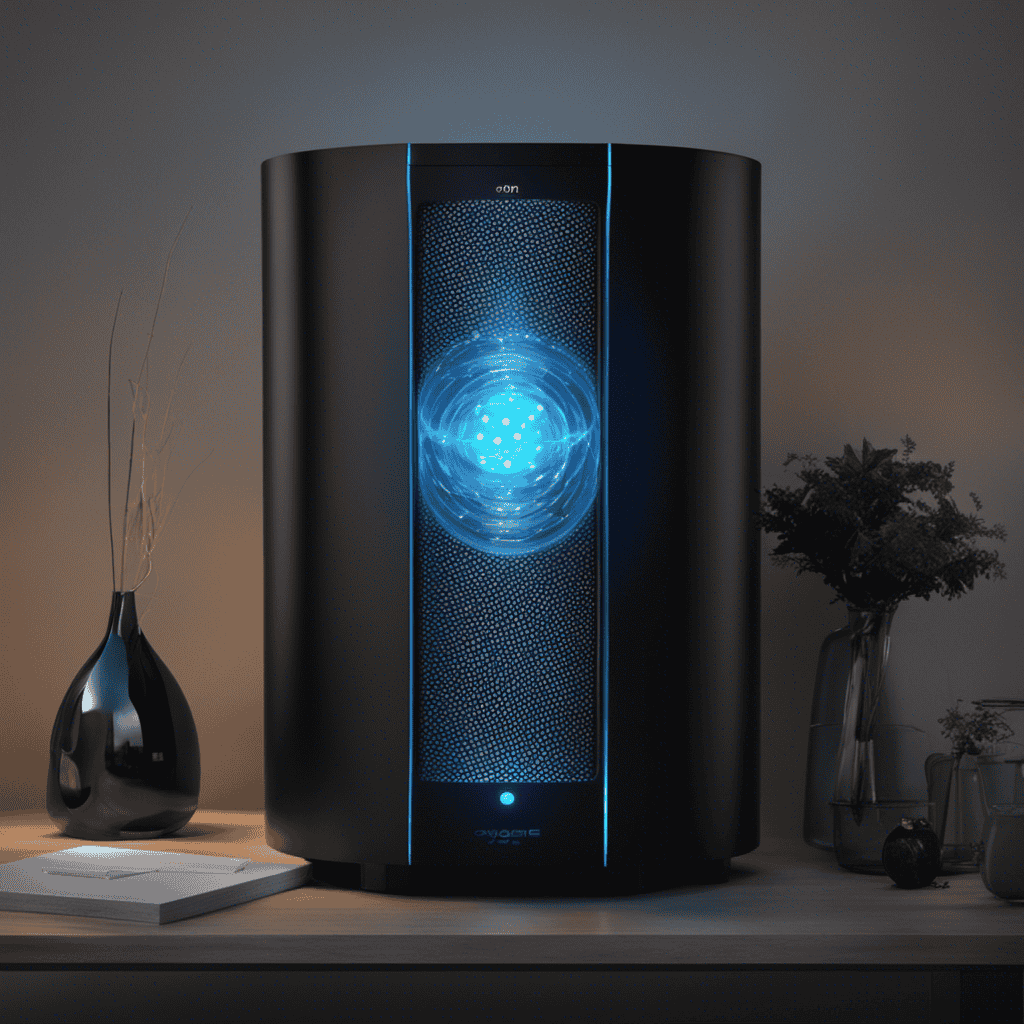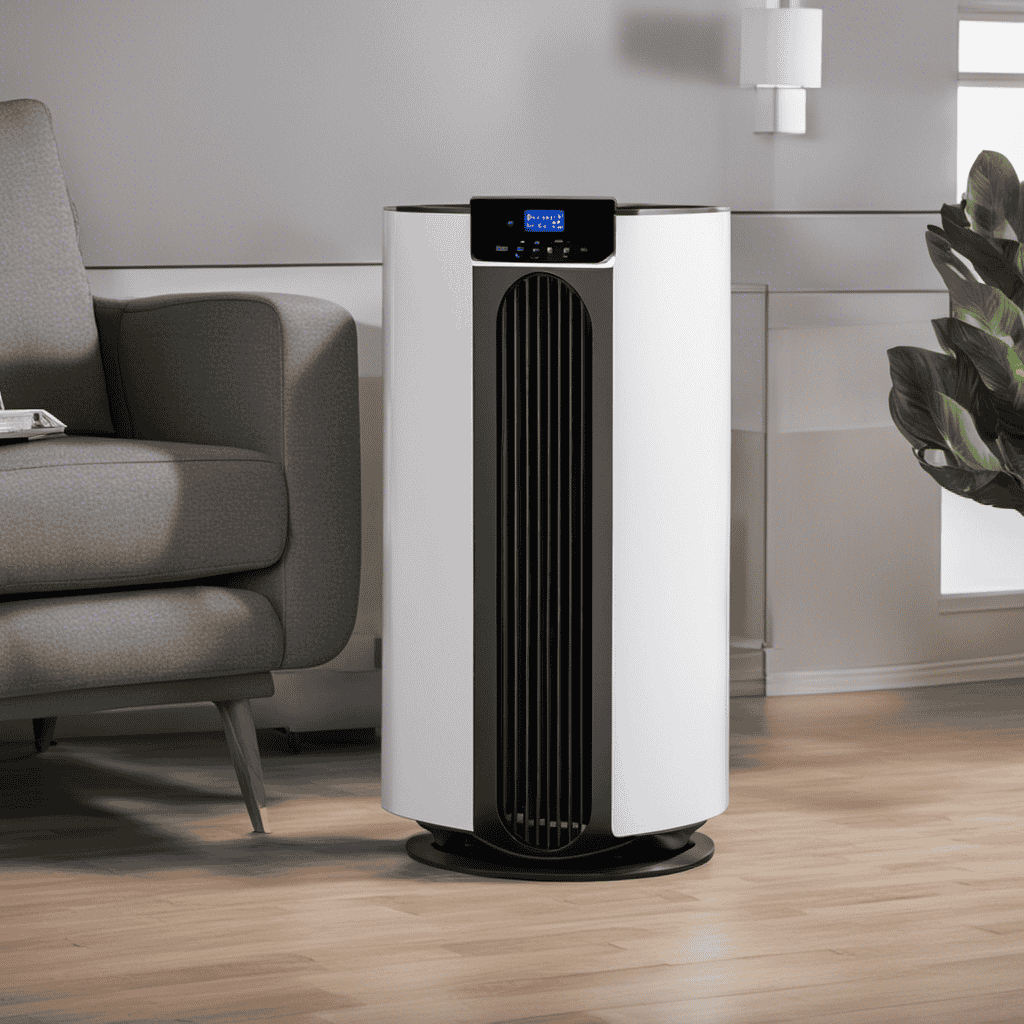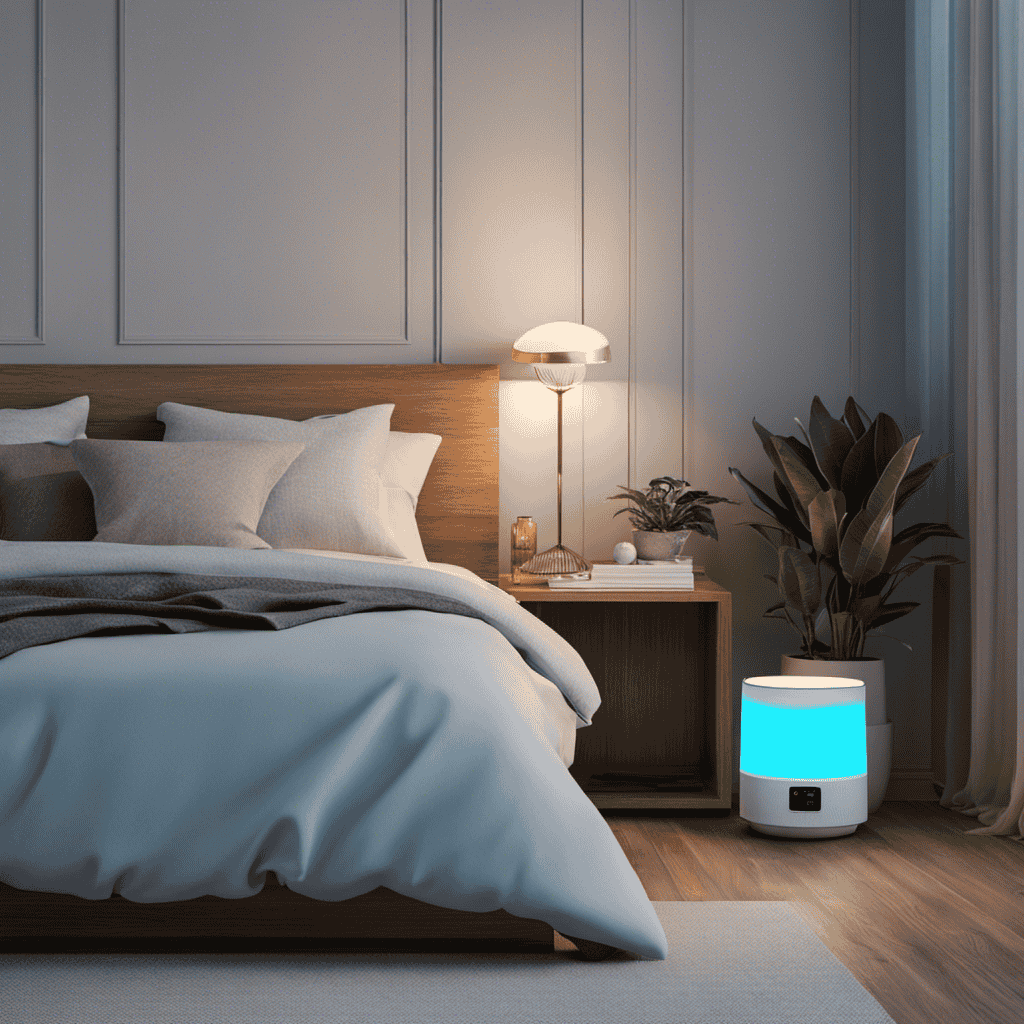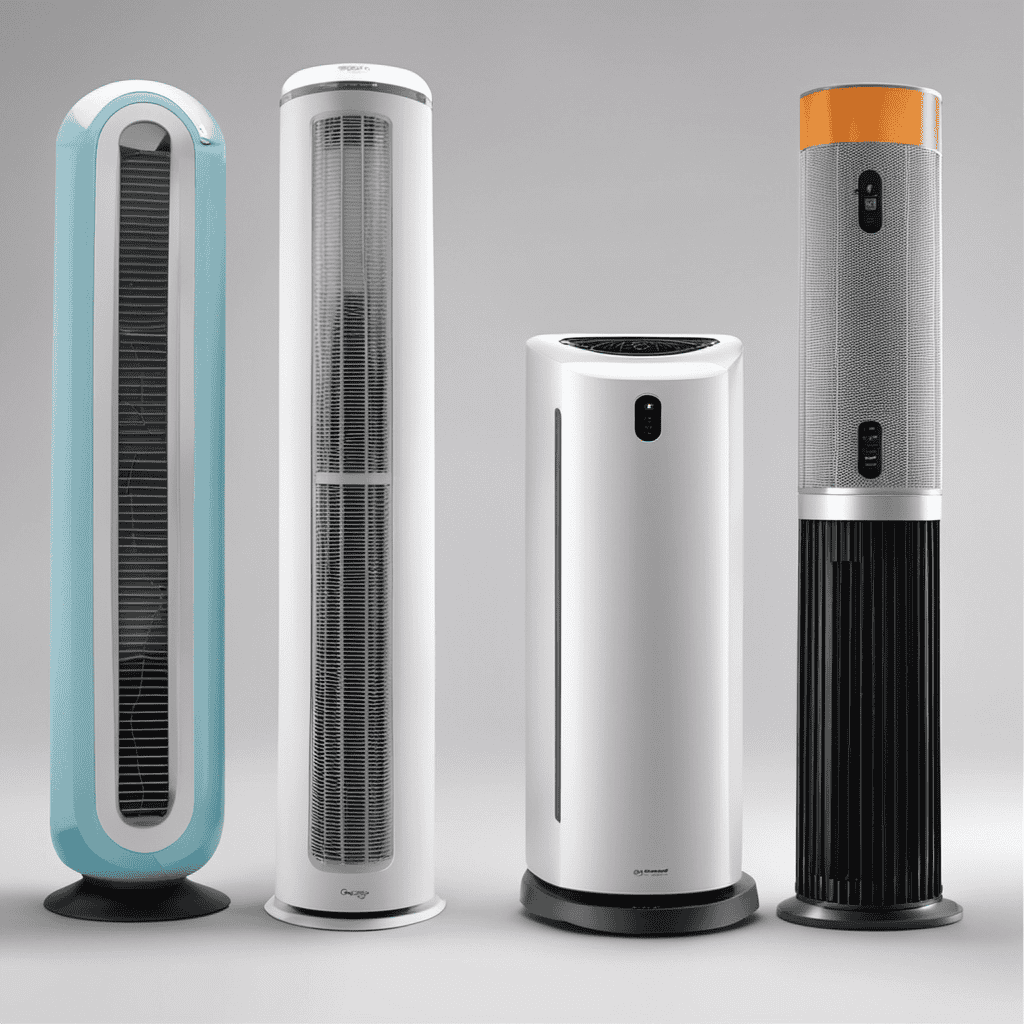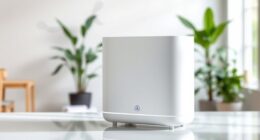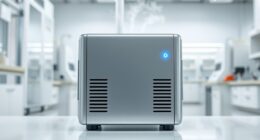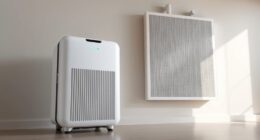As a person who values indoor air quality, I have always trusted air purifiers to create a healthier atmosphere. However, I have recently learned that not all air purifiers are the same. Some of them produce ozone, which can be detrimental to our health.
This realization made me dive into the world of ozone-free air purifiers and how to identify if an air purifier is producing ozone. In this article, I will share my findings and provide you with the necessary knowledge to make informed decisions about the air purifiers in your home.
Key Takeaways
- Ozone is a natural component of the Earth’s atmosphere but can be harmful to human health in high concentrations.
- Certain types of air purifiers, such as ionizers, UV-C germicidal lamps, and electrostatic precipitators, can generate ozone.
- It is important to choose air purifiers that are ozone-free to protect indoor air quality and health.
- Signs of ozone generation in air purifiers include a strong odor similar to chlorine or bleach, worsened respiratory symptoms, and visible blue or purple light.
Understanding Ozone and Air Purifiers
The first step in understanding if an air purifier is generating ozone is to know what ozone is and how it is produced.
Ozone is a gas composed of three oxygen atoms (O3). It is a natural component of the Earth’s atmosphere and plays a crucial role in protecting us from harmful ultraviolet radiation from the sun.
However, at ground level, ozone can be harmful to human health, particularly in high concentrations. Ozone exposure can lead to respiratory problems such as coughing, wheezing, and shortness of breath.
To protect public health, various regulatory agencies have established ozone exposure limits. These limits define the maximum ozone concentration that is considered safe for human exposure. It is important to consider these limits when assessing the ozone emissions of an air purifier.
Types of Air Purifiers and Ozone Production
Check out different types of air purifiers to see which ones produce ozone. When it comes to air purifiers, it’s important to understand their ozone production capabilities. Ozone is a gas that can be harmful to our health, especially when present in high concentrations indoors.
Here are three common types of air purifiers and their potential for ozone production:
-
Ionizers: These air purifiers release negatively charged ions into the air, which attach to airborne particles and cause them to fall to the ground. Some ionizers can also produce ozone as a byproduct, so it’s essential to check their ozone output levels.
-
UV-C Germicidal Lamps: These purifiers use ultraviolet light to kill bacteria, viruses, and other microorganisms. While they are effective at disinfection, some UV-C lamps can generate ozone. Look for models with low or no ozone emission.
-
Electrostatic Precipitators: These devices charge particles in the air and collect them on oppositely charged plates. Some electrostatic precipitators can unintentionally produce ozone. Ensure you choose a model that is ozone-free.
The Importance of Ozone-Free Air Purifiers
Make sure you choose an air purifier that is free of ozone to protect your indoor air quality and health. Ozone, a molecule made up of three oxygen atoms, can be harmful when present in high concentrations. While ozone is beneficial in the upper atmosphere, at ground level it can cause respiratory issues, throat irritation, and even lung damage. That’s why it’s crucial to opt for an air purifier that does not generate ozone as a byproduct. To help you make an informed decision, here is a comparison table of common air purifier types and their ozone generation levels:
| Air Purifier Type | Ozone Generation |
|---|---|
| HEPA | Negligible |
| Activated Carbon | Negligible |
| Ionic | Low |
| UV-C | Low |
Signs to Look for in Ozone-Generating Air Purifiers
Be mindful of the signs that indicate an air purifier may be generating ozone, as this could potentially harm your respiratory system. Ozone is a harmful gas that can worsen indoor air pollution and lead to health issues when inhaled. Here are three signs to look for in ozone-generating air purifiers:
-
Strong Odor: If you notice a strong, pungent smell similar to chlorine or bleach, it may be a sign that your air purifier is producing ozone. Ozone has a distinct smell that is often described as sharp and metallic.
-
Respiratory Symptoms: Pay attention to any respiratory symptoms that worsen when the air purifier is in use. These symptoms may include coughing, wheezing, chest tightness, or shortness of breath. Ozone exposure can irritate the respiratory system and trigger asthma attacks.
-
Visible Ozone: Some ozone-generating air purifiers produce a visible blue or purple light. This light indicates the presence of ozone, as ozone molecules scatter light in these colors. If you see this light, it is a clear sign that your air purifier is generating ozone.
It is important to choose an air purifier that does not produce ozone to ensure the safety of your indoor air quality and respiratory health.
Testing Ozone Levels in Your Home
To accurately measure the levels of ozone in your home, you can use an ozone detector or hire a professional to conduct the testing.
Ozone detectors are portable devices that can be purchased online or at hardware stores. They work by measuring the concentration of ozone in the air and providing a reading in parts per billion (ppb). To use an ozone detector, simply turn it on and place it in the area you want to test. It will then give you a reading of the ozone levels in that specific location.
Hiring a professional to conduct ozone testing is another option. They have specialized equipment and knowledge to accurately measure ozone levels in your home. It is important to follow safety measures while conducting ozone testing, such as ensuring proper ventilation and wearing protective gear.
Common Misconceptions About Ozone and Air Purifiers
When it comes to air purifiers and ozone, there are many misconceptions that need to be debunked. People often have incorrect beliefs about the safety of ozone and its role in air purification. Here are three common myths about ozone and air purifiers:
-
Ozone is always harmful: While high levels of ozone can be harmful to human health, not all levels of ozone are dangerous. Air purifiers that generate ozone within safe and regulated limits can effectively remove pollutants from the air without posing a risk to our well-being.
-
Ozone is the only effective way to purify the air: This is not true. There are various types of air purifiers available that can effectively remove pollutants without generating ozone. These include HEPA filters, activated carbon filters, and electrostatic precipitators.
-
Ozone is necessary to eliminate all types of pollutants: While ozone can help eliminate some pollutants, it is not effective in removing all types of contaminants. Different air purifiers target specific pollutants, so it’s important to choose the right one based on your specific needs.
Health Risks Associated With Ozone-Producing Air Purifiers
The health risks of ozone-producing air purifiers should not be ignored, as they can potentially harm human well-being. Ozone exposure, even at low levels, can cause respiratory issues such as coughing, throat irritation, and shortness of breath. Prolonged exposure to high levels of ozone can lead to more severe health problems, including lung damage and increased susceptibility to respiratory infections. It is important to be aware of the dangers associated with these types of air purifiers and take necessary precautions to protect ourselves.
Here is a table to illustrate the potential health risks of ozone-producing air purifiers:
| Health Risks | Symptoms |
|---|---|
| Respiratory | Coughing, throat irritation, |
| issues | shortness of breath |
| Lung damage | Decreased lung function, |
| increased risk of infections |
To ensure the well-being of yourself and your loved ones, it is crucial to choose an air purifier that doesn’t generate ozone. This will be discussed in the subsequent section.
How to Choose an Air Purifier That Doesn’t Generate Ozone
When it comes to choosing an air purifier that doesn’t generate ozone, there are a few key points to consider.
First, it’s important to understand what ozone-free air purifiers are and how they differ from ozone-generating models.
Secondly, evaluating the ozone generation of an air purifier can be challenging, but there are several indicators and tests that can help determine whether it produces ozone.
Lastly, certifications for ozone-free purifiers, such as the California Air Resources Board (CARB) certification, can provide assurance that the purifier meets strict standards for ozone emissions.
Ozone-Free Air Purifiers
There aren’t any air purifiers that generate ozone. Ozone-free technology has become the standard for air purifiers due to the potential health risks associated with ozone exposure. Here are three benefits of using ozone-free purifiers:
-
Improved air quality: Ozone-free purifiers effectively remove pollutants such as dust, pollen, pet dander, and mold spores from the air, improving overall air quality and reducing the risk of respiratory issues.
-
Safe for everyone: Ozone-free purifiers are safe for people of all ages, including children and those with respiratory sensitivities or compromised immune systems. They do not emit harmful ozone, ensuring the well-being of everyone in the room.
-
Environmentally friendly: Ozone-free purifiers are more environmentally friendly as they do not release ozone into the atmosphere. They contribute to a healthier planet by not adding to air pollution.
By choosing an ozone-free air purifier, you can enjoy cleaner air without the risks associated with ozone generation.
Now, let’s explore how to evaluate if an air purifier is generating ozone.
Evaluating Ozone Generation
One way to determine if an air purifier is producing ozone is by checking its specifications for ozone emissions. Ozone emissions are a concern because high levels of ozone can be harmful to human health.
When evaluating ozone levels, it is important to monitor ozone emissions to ensure they are within safe limits. Ozone can irritate the respiratory system and cause respiratory problems, especially for individuals with asthma or other respiratory conditions.
It is recommended to look for air purifiers that are certified as ozone-free or have low ozone emissions. These certifications ensure that the air purifier has been tested and meets specific standards for ozone emissions.
Certifications for Ozone-Free Purifiers
When it comes to choosing an air purifier, it’s important to look for certifications that guarantee ozone-free operation. These certifications ensure that the purifier does not emit harmful ozone into the air, providing you with clean and safe indoor air quality.
Here are three well-known certifications for ozone-free purifiers:
-
California Air Resources Board (CARB) Certification: This certification ensures that the air purifier complies with the strictest ozone emission limits set by the state of California. It is widely recognized and trusted.
-
Association of Home Appliance Manufacturers (AHAM) Certification: AHAM verifies that the air purifier meets specific ozone emission standards, ensuring it is ozone-free and safe for use in your home.
-
Underwriters Laboratories (UL) Certification: UL tests and certifies the purifier’s ozone-free claims, giving you peace of mind that the product meets industry standards.
Choosing an ozone-free air purifier has many benefits, including:
-
Improved respiratory health: Ozone can irritate the respiratory system, so an ozone-free purifier reduces the risk of breathing difficulties and other respiratory issues.
-
Enhanced overall well-being: Clean air free from ozone can contribute to a healthier and more comfortable living environment.
-
Environmental responsibility: Ozone-free purifiers help protect the environment by not releasing harmful substances into the air.
Tips for Maintaining an Ozone-Free Indoor Environment
When it comes to maintaining an ozone-free indoor environment, there are a few key points to keep in mind.
Firstly, it’s important to understand the sources of ozone emissions and take steps to avoid them.
Secondly, ensuring proper ventilation and air circulation can help to reduce ozone levels.
Finally, choosing ozone-free products and appliances can also contribute to better air quality in your home or office.
Ozone-Free Air Quality
There’s no need to worry about ozone levels in the air if you have an ozone-free air purifier. Ozone, a gas composed of three oxygen atoms, can be harmful when present in high concentrations. To ensure that your air purifier is truly ozone-free, consider the following:
-
Look for certifications: Check if the air purifier has been tested and certified by reputable organizations, such as the California Air Resources Board (CARB) or the Association of Home Appliance Manufacturers (AHAM).
-
Read product specifications: Look for explicit statements indicating that the air purifier does not produce ozone. Avoid ambiguous language like ‘low ozone emission’ or ‘ozone-safe,’ as these can still mean there is some ozone generation.
-
Customer reviews: Read reviews from other users to see if anyone has reported experiencing ozone-related issues with the air purifier.
Avoiding Ozone Emissions
To avoid ozone emissions, make sure to carefully review the certifications and product specifications of any air purifier you are considering purchasing. Ozone is a harmful gas that can worsen respiratory conditions and cause other health issues. To ensure that an air purifier does not generate ozone, look for certifications such as the California Air Resources Board (CARB) and the Underwriters Laboratories (UL) ozone-free certification. These certifications indicate that the air purifier has undergone testing to ensure it does not produce ozone. Additionally, check the product specifications for information on ozone detection methods and ozone exposure limits. This will help you select an air purifier that effectively removes pollutants without emitting ozone, ensuring clean and safe indoor air quality.
| Certifications | Product Specifications |
|---|---|
| CARB ozone-free certified | Ozone detection method: Electrochemical sensor |
| UL ozone-free certified | Ozone exposure limit: <0.05 parts per million (ppm) |
Frequently Asked Questions
What Are the Potential Health Risks Associated With Ozone-Generating Air Purifiers?
Potential dangers of ozone-generating air purifiers include respiratory irritation, coughing, and shortness of breath. Long-term effects may include lung damage and worsening of existing respiratory conditions. It is important to be aware of these risks when using such devices.
How Do I Test the Ozone Levels in My Home?
I’m not sure if my air purifier is generating ozone. To find out, I can use ozone testing methods and measurement devices. This will help me determine the levels of ozone in my home.
Are There Any Common Misconceptions About Ozone and Air Purifiers That I Should Be Aware Of?
Common misconceptions about ozone and air purifiers include the belief that ozone is always harmful and that all air purifiers generate ozone. It’s important to note that ozone can have harmful effects in high concentrations, but not all air purifiers produce ozone.
What Are the Different Types of Air Purifiers That Produce Ozone?
There are different types of ozone generating air purifiers, each with varying levels of ozone emission. It is important to be aware of these types and their potential impact on indoor air quality.
Are There Any Tips for Maintaining an Ozone-Free Indoor Environment?
To maintain an ozone-free indoor environment, here are some tips: 1) Avoid using air purifiers that produce ozone. 2) Limit the use of products that emit ozone, like certain cleaning agents.
Conclusion
In conclusion, it is crucial to ensure that your air purifier isn’t generating ozone. Ozone can be harmful to your health and cause respiratory issues. Understanding the types of air purifiers and signs of ozone-generating ones helps you make an informed decision. Testing ozone levels in your home and maintaining an ozone-free indoor environment are essential steps in safeguarding your health. Remember, clean air shouldn’t come at the cost of ozone pollution.
